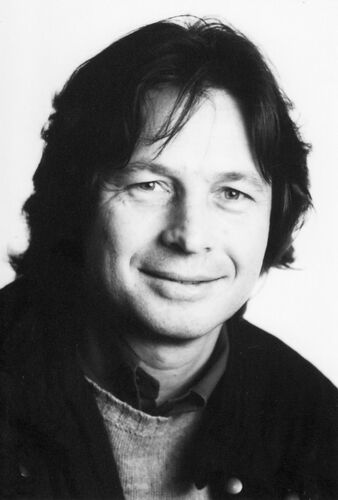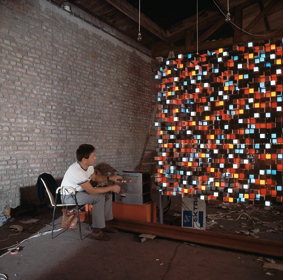Vladimir Bonačić
 | |
| Born |
October 20, 1938 Novi Sad, Serbia, Yugoslavia |
|---|---|
| Died |
August 15, 1999 (aged 60) Ittenbach, Germany |
Vladimir Bonačić (1938-1999) was a Croatian computer artist and cybernetician.
Life and work[edit]
Born 1938 in Novi Sad, Yugoslavia. Grew up in Zagreb and studied nuclear electronics at the Faculty of Electrical Engineering and Computing, University of Zagreb (M. Sc. 1964) Postgraduate studies in London and Paris. Earned his PhD in 1967 in the field of pattern recognition and hidden data structures, at the university of Zagreb.
Bonačić worked in the Croatian National Research Ruđer Bošković Institute (RBI) in Zagreb from 1964, where he headed the Laboratory of Cybernetics from 1969 to 1973. In 1968 he started to utilize computer systems for cybernetic art. In 1970-1972 he led the research project "Pattern Recognition and Processing" at the RBI. At that time the also began development of "Computer Controlled Dynamic Object" with the support of UNESCO; and in 1971 served as an advisor to the UNESCO on art and science matters. Exhibited his first dynamic objects within New Tendencies exhibition in Zagreb in 1969, altogether 17 works, and then again in 1973. He worked together with Ivan Picelj, and since 1967 with a software designer Miro A. Cimerman. His first solo exhibition took place in Ljubljana in 1972.
On the basis of an agreement between the Ruđer Bošković Institute and the Israel Academy of Sciences Bonačić established a laboratory team for cybernetics, bcd, together with Cimerman and an architect and city planner Dunja Donassy (1971). In 1972 bcd - cybernetic art team moved to Israel and in 1973 founded the "Jerusalem Program in Art and Science", a research and training program for post-graduate interdisciplinary studies in art and science at the Bezalel Academy of Arts and Design in Jerusalem, which Bonačić directed until 1977, serving as a professor of computer-based art. For this program he established collaborations with the Hebrew University of Jerusalem and the Israel Museum. On 3-14 November 1974 he organized an international Bat Sheva seminar on The Interaction of Art and Science, in which several New Tendencies protagonists, such as Jonathan Benthall, Herbert W. Franke, Frank Joseph Malina, Abraham A. Moles, A. Michael Noll, and John Whitney, participated. In 1975, Willem Sandberg, a Dutch typographer and director of the Stedelijk Museum, received the Erasmus Prize in Amsterdam. On Sandberg's recommendation, half of the prize was dedicated to "The Jerusalem Program in Art and Science".[1]
In 1973 he became a member of the editorial advisory board of the journal Leonardo. 1978/1979 head of development of the multimedia and electronic library at the national library of Croatia, Zagreb, and the central library of the University of Zagreb. Moved to Germany in 1980 where he undertook R&D projects primarily in visual communications used by German television for election night reporting. He died 1999 in Germany.
Works[edit]
- Application of Galois fields to kinetic computer-art objects
PLN 6. Computer-generated image. PDP-8, oscilloscope, 1969. [1]
- 'True randomly generated' kinetic object
Random 63. 63 true random generators, light bulbs, aluminum, 76 × 76 × 7 cm, 1969. [2]
- Public space computer-controlled light installations
Notes[edit]
- ↑ Fritz, Darko (2010). "The Computer-Generated Artworks of Vladimir Bonačić". London: CAT 2010 London Conference: p 43.
Writings[edit]
- Tačnost kod sistema za ispitivanje sadržaja iz cirkulirajuće memorije amplitudnih analizatora, Zagreb, 1966, 3 pp. (Serbo-Croatian)
- Pseudo-slučajna transformacija podataka u asocijativnoj analizi kompjuterom, Zagreb: Faculty of Electrical Engineering/University of Zagreb, 1968. Ph.D. thesis. (Serbo-Croatian)
- "Mogućnosti kompjutera u vizualnim istraživanjima" / "Possibilities for Computer Applications in Visual Research", trans. Vilim Crlenjak, Bit International 3: "International Colloquy Computers and Visual Research", ed. Božo Bek, Zagreb: Galerije grada Zagreba, 1968, pp 45-58. Paper read at the Colloquy Computers and Visual Research in the framework of New Tendencies, Zagreb, 4-5 Aug 1968. (Serbo-Croatian)/(English)
- "Umjetnost kao funkcija subjekta" / "Arts as Function of Subject, Cognition, and Time", trans. Miroslav Beker, Bit International 7: "Dialogue with the Machine", ed. Božo Bek, Zagreb: Galerije grada Zagreba, 1971, pp 129-142. Paper read at the symposium Computers and Visual Research in the framework of New Tendencies, Zagreb, 5-6 May 1969. Repr. of excerpt. (Serbo-Croatian)/(English)
- "Program on Art and Science at Bezalel Academy Jerusalem", Leonardo 7:1, Winter 1974, pp 31-32. (English)
- "Kinetic Art: Application of Abstract Algebra to Objects with Computer-Controlled Flashing Lights and Sound Combinations", Leonardo 7:3, Summer 1974, pp 193-200.
- "Book Review: II. Cultural Policy in Yugoslavia by Stevan Majstorović", Leonardo 9:1, 1976, pp 73-74. (English)
- "On the Boundary Between Science and Art", Impact of Science on Society 27(1): "On the Frontiers of Science", Jan/Mar 1977, p 25. (English)
- "Book Review: Shape Grammars and Their Uses: Artificial Perception, Shape Generation and Computer Aesthetics by James Gips, Pictorial and Formal Aspects of Shape and Shape Grammars: On Computer Generation of Aesthetic Objects by George Stiny", Leonardo 10:4, 1977, pp 339-340. (English)
- "An On-Line Information Network for a National and University Library", Impact of Science on Society 28(3): "Computers and Social Options", Jul-Sep 1978, pp 233-234. (English)
- "Čovjek-jezik-materija ili dematerijalizacija umjetnosti" [Man, Language, Matter - The Dematerialization of Art], paper read at the symposium Umjetnost i društvo [Art and Society], Zagreb, 1978, MSU Zagreb Archive. (Serbo-Croatian)
- with Curtis L. Carter, "A Pictorial Syntax of Shapes (Continued)", Leonardo 11:1, Winter 1978, pp 86-87. (English)
- "Book Review: Every Object Is a System: A Cognitive Basis for System Description", Leonardo 14:1, 1981, p 66. [3] (English)
- "Comments on Digitization as Transformation", Leonardo 18:1, 1985, p 55. (English)
- "A Transcendental Concept for Cybernetic Art in the 21st Century", Leonardo 22:1, 1989, pp 109-111. Originally published in Visions for Cybernetic Art, exhib. cat., Paris Art Center, Académie Européenne des sciences, des arts et des letters, Paris, 1987. (English)
Catalogues[edit]
- Vladimir Bonačić, intro. Božo Bek, ed. Majda Jerman, Ljubljana: Mala galeria, 1972, [20] pp. (Slovenian)/(French)
Literature[edit]
- Ješa Denegri, "Uz vizuelna istraživanja Vladimira Bonačića", Život umjetnosti 14, Zagreb: Matica hrvatska, 1971, pp 47-50. (Croatian)
- Darko Fritz, "Vladimir Bonačić - Early Works, Zagreb 1968-1971", CIP, no. 07-08, 2006, UHA, Zagreb, pp. 50-55. [4] [5] (English)/(Croatian)
- Darko Fritz, "Vladimir Bonačić: Computer-Generated Works Made Within Zagreb’s New Tendencies Network (1961–1973)", Leonardo 41:2, Apr 2008, pp 175-183. [6] (English)
- Boris Čučković, "Vladimir Bonačić: objekti, urbane instalacije i primijenjeni pseudoslučaj. Zagreb 1968 – Jeruzalem 1978", Rector award winning papers published on official pages of the University of Zagreb. Zagreb: University of Zagreb, Faculty of Humanities and Social Sciences, 2010. (English)
- Darko Fritz, The Work of Vladimir Bonačić: A Temporary Realization of the New Tendencies’ Program", 2010. (English)
- Darko Fritz, "The Computer-Generated Artworks of Vladimir Bonačić", CAT 2010 London Conference, 2010. [7] (English)
- Margit Rosen, Dunja Donassy-Bonačić, Miro A. Cimerman, "Vladimir Bonačić & bcd CyberneticArt team: CyberneticArt", Karlsruhe: ZKM, 2019, 73 min. Video. Event. (German)














